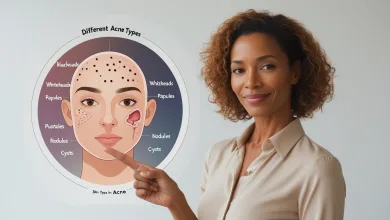The Best Acne Products for Every Skin Type and Budget

Finding Your Perfect Acne-Fighting Match
Let’s face it — dealing with acne isn’t just a teenage nightmare. It’s a stubborn companion that can stick around well into adulthood, showing up uninvited at the worst possible moments. Whether you’re battling occasional breakouts or waging war against chronic acne, finding the right products can feel like searching for a needle in a haystack. And boy, isn’t it frustrating when that expensive miracle product your friend swears by does absolutely nothing for your skin?
That’s where we come in! This comprehensive guide to the best acne products for every skin type and budget cuts through the noise of endless skincare options. We’ll explore solutions ranging from wallet-friendly drugstore finds to splurge-worthy investments, all tailored to different skin types. Because your skin deserves personalized care, not one-size-fits-all treatments that might do more harm than good. By the time you finish reading, you’ll have a clear roadmap to clearer skin — without unnecessary trial and error or wasted money.
Understanding Your Skin Type: The Foundation of Effective Acne Treatment
Before diving headfirst into product recommendations, let’s get something straight — knowing your skin type is non-negotiable when battling acne. It’s like trying to build a house without checking the foundation first. Disaster waiting to happen!
Your skin type isn’t just some marketing gimmick invented by skincare companies. It’s a legitimate biological characteristic that significantly impacts how your skin reacts to different ingredients and formulations. The treatment that works wonders for your oily-skinned friend might turn your dry skin into an irritated, flaky mess.
How to Determine Your Skin Type
Not sure what skin type you’re dealing with? Here’s a quick crash course:
- Oily Skin: Appears shiny throughout the day, especially in the T-zone. Pores are typically more visible, and you might deal with frequent breakouts. Your makeup seems to slide off by midday.
- Dry Skin: Feels tight after cleansing, might have flaky patches, and rarely looks shiny. Fine lines may be more visible, and your skin absorbs moisturizer like a sponge.
- Combination Skin: The classic “oily T-zone, dry cheeks” situation. Different areas of your face have different needs, making treatment a balancing act.
- Sensitive Skin: Easily irritated, might sting or burn after product application. Prone to redness and reactivity, requiring gentler ingredients.
- Normal Skin: The skincare lottery winner! Not too oily, not too dry, with minimal sensitivity. Still not immune to acne, though!
Pro tip: The “tissue test” is a reliable DIY method to determine your skin type. Press a clean facial tissue against your face in the morning before applying any products. If oil shows up on the tissue, you’ve got oily or combination skin. No oil? You’re likely dealing with dry or normal skin.
Budget-Friendly Acne Solutions That Actually Work
Who says you need to empty your wallet for clear skin? Some of the most effective acne-fighting ingredients are available in affordable formulations that deliver serious results. Let’s break down some budget heroes that won’t leave your bank account crying.
Drugstore Cleansers: The Foundation of Any Acne Routine
Your cleansing step can make or break your acne treatment strategy. Thankfully, some of the best acne-fighting cleansers can be found right in the drugstore aisle!
CeraVe’s Foaming Facial Cleanser (around $15) has developed a cult following for good reason. It contains ceramides that help maintain your skin barrier while salicylic acid works to unclog pores. What’s especially impressive is how it manages to deeply clean without that awful tight, stripped feeling that many acne cleansers leave behind.
Another budget superstar is Neutrogena’s Oil-Free Acne Wash (approximately $8), which has been around forever and still holds its own against newer, fancier options. It contains salicylic acid that penetrates deep into pores to dissolve the gunk that leads to breakouts. It’s particularly effective for oily and combination skin types who need that deeper clean.
Affordable Treatments: Targeted Solutions Without the Sticker Shock
When it comes to spot treatments and overall acne management, The Ordinary has revolutionized the budget skincare game. Their Niacinamide 10% + Zinc 1% formula (around $6) helps regulate sebum production and reduce inflammation — two key factors in acne development. It’s a water-based serum that layers beautifully under moisturizer and doesn’t pill up under makeup, making it ideal for daytime use.
Don’t overlook the power of Differin Gel (adapalene 0.1%), which was previously prescription-only but is now available over the counter for about $15. This retinoid helps speed up cell turnover and prevent clogged pores, addressing acne before it even forms. While it requires patience (results typically appear after 8-12 weeks of consistent use), the scientific evidence supporting its effectiveness is rock solid.
Mid-Range Products Worth Every Penny
Sometimes investing a bit more in your skincare routine can yield better results, especially if you’re dealing with persistent or severe acne. The mid-range category offers sophisticated formulations and concentrated ingredients that often provide more noticeable results.
Advanced Cleansers: Deep Clean Without the Damage
Paula’s Choice CLEAR Pore Normalizing Cleanser (around $26) exemplifies the “gentle but effective” approach that’s ideal for acne-prone skin. The 2% salicylic acid formulation removes excess oil and unclogs pores without disrupting your skin’s moisture barrier. What’s particularly impressive is how it manages to treat existing breakouts while preventing new ones.
For those with sensitive, acne-prone skin, La Roche-Posay’s Effaclar Medicated Gel Cleanser ($25) offers the perfect balance of effectiveness and gentleness. Containing 2% salicylic acid and lipo-hydroxy acid (LHA), it provides micro-exfoliation to clear pores while respecting the skin’s pH. The addition of glycerin helps maintain hydration, preventing the dryness that can trigger more breakouts.
Treatment Products: Targeted Solutions for Stubborn Acne
The Paula’s Choice 2% BHA Liquid Exfoliant ($34) has achieved legendary status in the skincare community, and with good reason. This leave-on exfoliant uses salicylic acid to penetrate oil-clogged pores and calm redness. What sets it apart is its non-irritating formula that includes green tea extract to soothe and provide antioxidant benefits. Users report visible improvements in skin texture and clarity within weeks.
Another standout in this category is Sunday Riley’s U.F.O. Ultra-Clarifying Face Oil ($40 for 0.5 oz). Despite the seemingly contradictory notion of using oil to treat oily, acne-prone skin, this formula combines 1.5% salicylic acid with tea tree oil and black cumin seed oil to fight breakouts while balancing the skin. The addition of licorice root helps fade post-acne marks, addressing both active breakouts and their aftermath.
High-End Acne Products: Worth the Splurge?
Let’s get real — sometimes those luxurious products with their elegant packaging and hefty price tags do deliver exceptional results. But are they necessary? And which ones actually earn their keep in your skincare routine?
Premium Cleansers: Beyond Basic Clean
If you’re ready to invest in a cleansing experience that transforms this daily chore into a ritual, the iS Clinical Cleansing Complex ($48) might be your perfect match. This gentle yet effective cleanser contains a blend of salicylic acid, white willow bark extract, and chamomile to thoroughly cleanse while respecting your skin’s natural balance. What makes it stand out from cheaper alternatives is its ability to remove makeup, excess oil, and impurities without compromising the skin barrier — a crucial factor for acne-prone skin that’s often damaged by harsh cleansers.
Another luxury option that delivers tangible results is the SkinCeuticals Clarifying Exfoliating Cleanser ($39). Formulated with glycolic acid, salicylic acid, and glycerin, it addresses multiple aspects of acne-prone skin: excess oil, clogged pores, and the rough texture that often accompanies breakouts. Users report that it leaves skin feeling remarkably clean but not stripped — a delicate balance that many acne cleansers fail to achieve.
Investment Treatments: Science-Backed Solutions for Stubborn Acne
The Dr. Dennis Gross Alpha Beta Universal Daily Peel ($92 for 30 treatments) has achieved cult status among skincare enthusiasts, and it’s particularly effective for acne-prone skin. These pre-soaked treatment pads deliver a precisely calibrated blend of alpha and beta hydroxy acids to exfoliate, unclog pores, and smooth texture. The two-step process first exfoliates and then neutralizes, preventing the irritation that can trigger more breakouts. While the price point is undeniably high, many users find that these pads deliver results comparable to professional treatments.
For those battling both acne and signs of aging (yes, they can coexist!), SkinMedica’s Retinol Complex 0.5% ($80) offers sophisticated technology that maximizes results while minimizing irritation. The retinol is encapsulated for gradual release, reducing the redness and peeling often associated with retinoid treatments. Regular use not only prevents new breakouts but also fades post-acne marks and improves overall skin texture.
The Best Acne Products for Specific Skin Types
Now that we’ve explored options at different price points, let’s get even more specific. Your skin type dramatically impacts which acne products will work best for you.
Oily Skin: Controlling Excess Sebum Without Over-Drying
If you’re constantly battling shine and enlarged pores, your skincare routine needs to focus on controlling oil production without stripping your skin (which, counterintuitively, can trigger even more oil production).
The Inkey List’s Niacinamide Oil Control Serum ($10) is a budget-friendly superstar that regulates sebum production while strengthening the skin barrier. The 10% niacinamide concentration is ideal for oily skin, and the addition of hyaluronic acid ensures your skin stays hydrated.
For a more intensive treatment, consider Paula’s Choice 10% Azelaic Acid Booster ($39), which combines azelaic acid with salicylic acid to target both excess oil and the inflammation associated with acne. This multitasking product also helps fade the post-acne marks that often plague oily skin types.
Dry Skin: Treating Acne Without Compromising Hydration
Contrary to popular belief, dry skin can absolutely experience acne — and treating it requires special consideration to avoid exacerbating dryness.
First Aid Beauty’s Ultra Repair Oil-Control Moisturizer ($30) strikes the perfect balance for acne-prone dry skin. It provides necessary hydration with hyaluronic acid while incorporating niacinamide and zinc PCA to control breakouts. The oil-free formula ensures it won’t clog pores or exacerbate acne.
For spot treatment, the La Roche-Posay Effaclar Duo Dual Action Acne Treatment ($32) contains benzoyl peroxide in a hydrating base, making it gentler on dry skin than many other spot treatments. It effectively targets existing breakouts while preventing the flakiness that often accompanies acne treatments.
Sensitive Skin: Gentle Yet Effective Solutions
Treating acne on sensitive skin requires a delicate approach that addresses breakouts without triggering irritation, redness, or discomfort.
Tower 28’s SOS Daily Rescue Facial Spray ($28) utilizes hypochlorous acid, a gentle yet effective antimicrobial ingredient that helps control acne-causing bacteria without irritation. It’s even gentle enough for use on skin conditions like eczema and rosacea, which often coexist with acne in sensitive skin types.
For a comprehensive treatment option, Renée Rouleau’s Anti Bump Solution ($51) was specifically formulated for those painful, deep cystic breakouts that often plague sensitive skin. The lactic acid and citric acid complex gently exfoliates while methyl gluceth 20 and allantoin soothe irritation and reduce redness.
Specialized Acne Concerns and Solutions
Beyond the basic skin types, specific acne concerns require targeted approaches. Let’s explore some common issues and the products designed to address them.
Hormonal Acne: Balancing Internal Factors From the Outside
Those deep, painful breakouts that appear like clockwork with your hormonal cycles require specialized treatment.
The Ordinary’s Granactive Retinoid 2% Emulsion ($10) provides a gentle retinoid experience that helps regulate cell turnover without the irritation of traditional retinol. This is particularly beneficial for hormonal acne, which tends to be inflammatory and easily aggravated by harsh treatments.
For a more specialized approach, Versed Skincare’s Game Over Acne Drying Treatment ($17) combines 2% sulfur with zinc oxide to specifically target hormonal breakouts. The addition of bentonite clay helps absorb excess oil in the affected areas without drying out the entire face.
Back and Body Acne: Solutions Beyond the Face
Acne doesn’t stop at your jawline, and treating body breakouts requires products formulated specifically for thicker skin and larger areas.
Neutrogena’s Body Clear Body Wash ($8) with 2% salicylic acid remains a reliable option for treating and preventing body acne. The lightweight gel formula rinses clean without leaving residue that could clog pores.
For a step up, PanOxyl Acne Foaming Wash with 10% Benzoyl Peroxide ($10) provides powerful antimicrobial action that’s particularly effective for the bacterial component of back and chest acne. While strong, the foaming formulation helps prevent the bleaching of fabrics that’s often associated with benzoyl peroxide products.
Building Your Personal Acne-Fighting Routine
Now that we’ve explored the best acne products for every skin type and budget, let’s talk about how to incorporate them into an effective routine that targets your specific concerns.
Consistency is Key: The Foundation of Success
The most expensive product in the world won’t work if you use it sporadically. Establishing a consistent routine—morning and night—creates the foundation for clear skin. Start with these basics:
- Gentle cleanser appropriate for your skin type
- Treatment product targeting your specific acne concerns
- Non-comedogenic moisturizer to maintain skin barrier health
- Broad-spectrum sunscreen (morning only) to prevent post-acne dark spots
Once this foundation is solid, you can add specialized treatments like exfoliants (2-3 times weekly) or targeted spot treatments as needed.
Patience Pays Off: Setting Realistic Expectations
Here’s something the skincare industry doesn’t want you to know: there’s no such thing as an overnight acne cure (despite what those flashy advertisements might claim). Most acne treatments require 6-8 weeks of consistent use before showing significant results. This is because skin cell turnover typically takes about 28 days in adults, meaning your skin needs time to respond to treatment.
Instead of jumping from product to product in search of instant results, commit to your chosen routine for at least two months before evaluating its effectiveness. Take weekly photos in consistent lighting to objectively track your progress, as day-to-day changes can be difficult to notice.
Frequently Asked Questions About Acne Products
Can I use multiple active ingredients at once?
While it’s tempting to throw everything but the kitchen sink at persistent acne, using too many active ingredients simultaneously can irritate your skin and worsen breakouts. As a general rule, limit yourself to one to two active ingredients per routine. For example, you might use a salicylic acid cleanser and a niacinamide serum in the morning, then a gentle cleanser and retinoid at night.
Certain ingredients like benzoyl peroxide and retinoids can deactivate each other, while others like AHAs/BHAs and retinoids can increase irritation when used together. When in doubt, alternate days or use one in your morning routine and another at night.
Is natural always better for acne-prone skin?
Despite the popular “clean beauty” movement, natural ingredients aren’t inherently better for acne-prone skin. In fact, some natural ingredients like coconut oil and cocoa butter can be highly comedogenic (pore-clogging). Conversely, scientifically developed ingredients like salicylic acid and benzoyl peroxide have decades of research supporting their safety and efficacy.
The most important factor isn’t whether an ingredient is natural or synthetic, but whether it’s appropriate for your specific skin concerns. Always check product formulations for potential irritants and comedogenic ingredients, regardless of whether they’re marketed as “natural” or not.
How do I know if a product is causing more breakouts?
Distinguishing between purging (a temporary increase in breakouts as skin cell turnover accelerates) and a genuine negative reaction can be challenging. Here’s a quick guide:
- Purging: Typically occurs in areas you normally break out, consists of faster-developing and faster-healing breakouts, and happens after introducing active ingredients like retinoids, AHAs, or BHAs.
- Breaking out: Appears in new areas, persists longer than normal, and often includes types of acne you don’t usually experience (like cystic breakouts if you normally have whiteheads).
If you suspect a product is causing actual breakouts rather than purging, discontinue use immediately. Purging, while unpleasant, should resolve within 4-6 weeks as your skin adjusts to the new product 26.
The Final Word: Personalized Approaches Win the Acne Battle
When it comes to the best acne products for every skin type and budget, there’s no universal miracle solution that works for everyone. The most effective approach combines understanding your unique skin needs, selecting appropriate products, and maintaining consistency with your routine.
Remember that skincare is just one piece of the acne puzzle. Factors like diet, stress, hormones, and even your pillowcase can influence breakouts. Consider a holistic approach that addresses multiple factors rather than relying solely on topical treatments.
If over-the-counter products aren’t yielding results after 2-3 months of consistent use, don’t hesitate to consult a dermatologist. Prescription options like spironolactone, isotretinoin, or custom-compounded formulations might be necessary for stubborn cases. There’s no badge of honor in suffering through severe acne when medical solutions are available.
The journey to clear skin is often a marathon, not a sprint. Be patient with your skin, adjust your routine as needed, and celebrate improvements along the way. With the right products and approach, clearer days are ahead!






